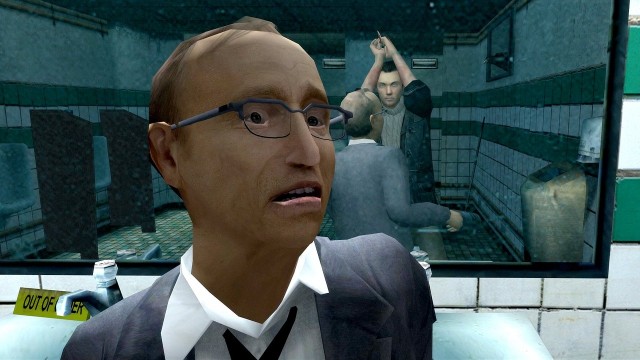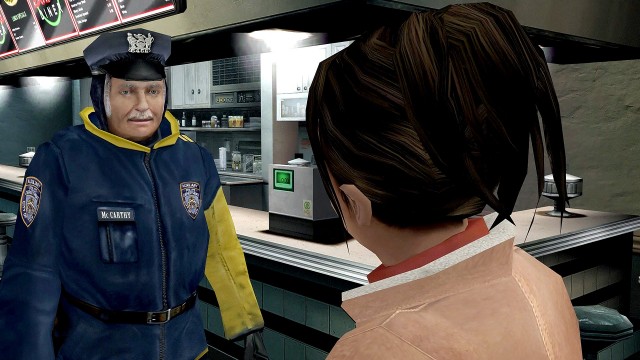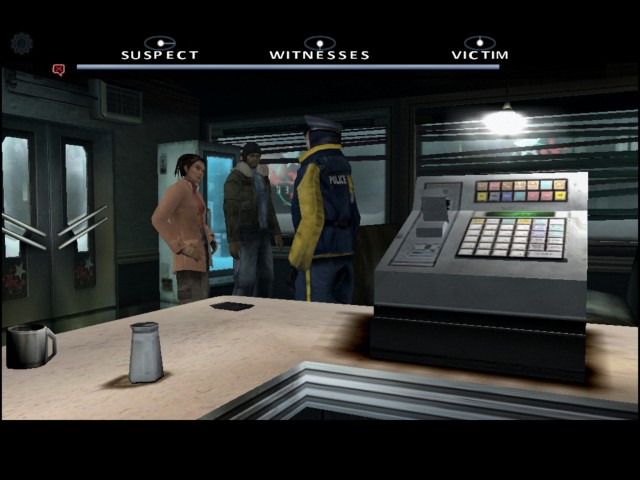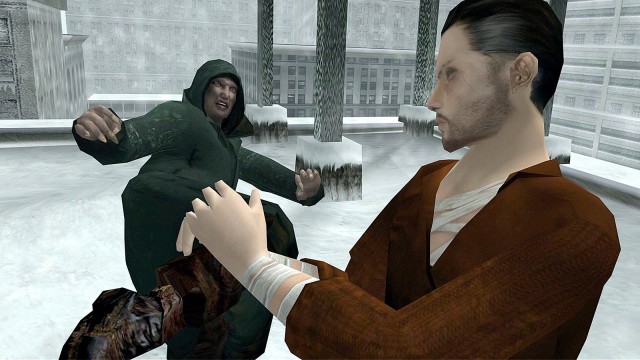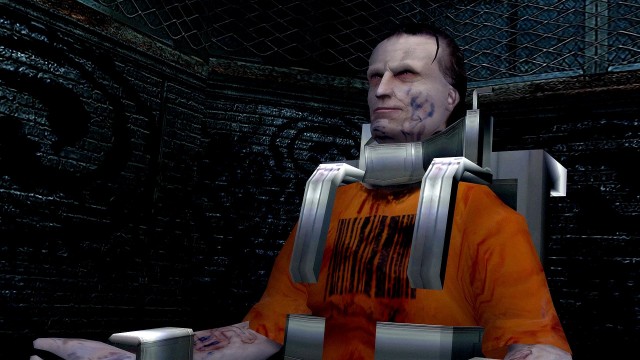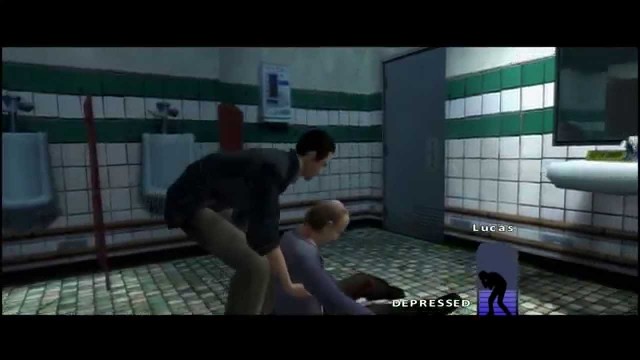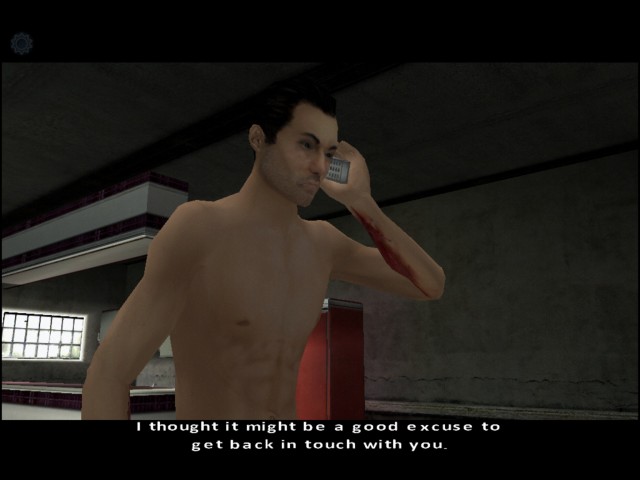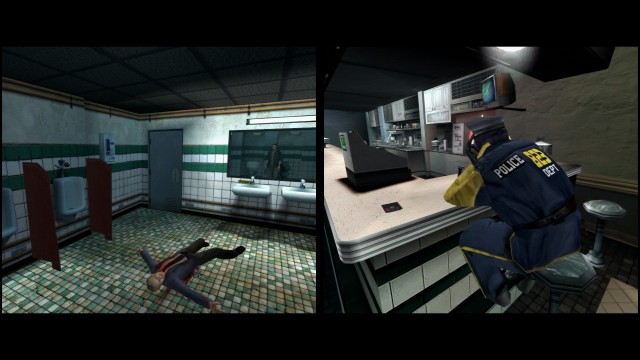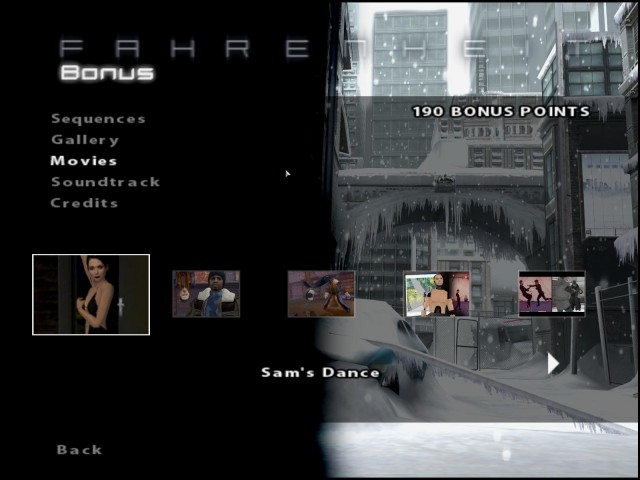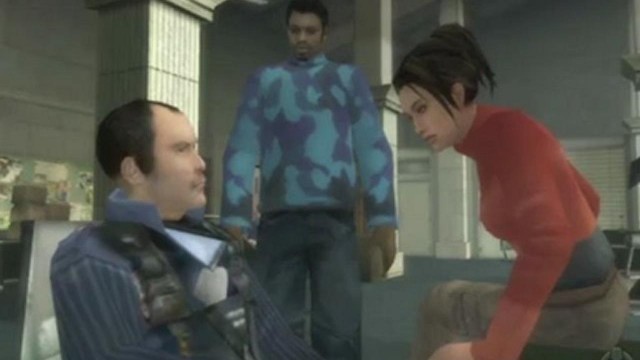Before cozying up to Sony to deliver the likes of Heavy Rain and Beyond: Two Souls, Quantic Dream released a rather interesting gaming experiment in 2005, which is largely credited with their breakout into the mainstream gaming space. This experiment was Indigo Prophecy, known as Fahrenheit in international territories (for whatever reason, then-publisher, Atari was worried that the game would be confused with then-recent movie release, Farenehit 9/11, so the North American version had its name changed), a game that first hit the PS2, Xbox and PC in 2005, and was met with heavy critical fascination, due to its hyper-cinematic presentation and highly mature storytelling.
2015 marks the tenth anniversary of Indigo Prophecy, and to observe the occasion, PC port specialty outfit, Aspyr has made a remaster of the game, which exclusively came to Steam and iOS, strangely skipping consoles altogether at this point. The remaster adds some touch-ups to the game, on top of re-introducing its original title for North American players, giving an HD overlay to the graphics, and adding gamepad support for those playing from Steam, something that wasn’t originally available in 2005’s PC version of Indigo Prophecy. For what it’s worth, the remaster also undoes the censored scenes in the original North American release of Indigo Prophecy, which restores some of the nudity that was present in the European version of the game.
This might sound intriguing if you’re a fan of Indigo Prophecy, but sadly, Fahrenheit: Indigo Prophecy Remastered is a disappointingly slapdash product, and one that also kind of backfires. Rather than show how timeless Indigo Prophecy is, Aspyr sadly ended up doing the opposite with Fahrenheit: Indigo Prophecy Remastered, showing how clunky, dated and occasionally laughable the game has become by modern standards. Making matters worse is that both the Steam and iOS releases of Fahrenheit: Indigo Prophecy Remastered are littered with technical issues, and even some game-breaking bugs if you’re really unlucky, which makes this supposed remaster come off as strangely unpolished.
If you want to re-experience Indigo Prophecy for its tenth anniversary, you’re better off either digging up your old PS2 or Xbox copy, or just paying the peanuts for one of the many second-hand copies at vintage game stores or online marketplaces. That may even be the best option if you’ve never tried the game before, and are curious about its interesting concept, since this remaster doesn’t even present the best way to play this already rather dated, shaky experience.
With the HD makeover awarded on both Steam and iOS, Fahrenheit: Indigo Prophecy Remastered shakes off at least a few of its long years. The environments look decent, if a little blocky on PC especially, and the character models for lead characters, Lucas Kane and Carla Valenti are actually not bad-looking. It’s still evident that the game was originally made for sixth-generation hardware in 2005, but at least Fahrenheit: Indigo Prophecy Remastered touches up the visuals enough to avoid everything feeling downright ugly.
Sadly, the visual touch-ups don’t seem to have applied everywhere though. One of the other lead characters, Tyler Miles, looks absolutely laughable, with static, false-looking expressions that don’t make him resemble a real human being anymore. Likewise, the secondary characters often have shakier and more ill-defined models as well, which aren’t as noticeable if you’re playing on an iPhone, but iPad and PC players will find that this game doesn’t look like its visuals have held up well.
Of course, this is before the slew of visual bugs that plague Fahrenheit: Indigo Prophecy Remastered to boot. The game is surprisingly unstable, considering that it’s a pretty bare-bones remaster of a game from 2005, with those playing on Steam being particularly prone to sudden freezes and crashes, which seem to purely happen at random. Depending on your rig, you may also encounter pop-in and loading hiccups, which, again, is rather shocking for a game that’s ten years old now, and barely touched up for the modern era.
Those playing on iDevices are slightly better off in terms of the visuals, with Fahrenheit: Indigo Prophecy Remastered looking at least decent on iPhone especially, and shedding at least a couple of the bugs that can show up when playing on Steam, even if not all of them. Even on slightly older iPad’s though, the game feels visually underwhelming, and like it’s a byproduct of a former era, since the visuals are blown up on the bigger screen in contrast to playing on an iPhone, which means higher resolution, and thus, more attention to the visual blemishes, which are even more distracting for PC players, especially those with top-of-the-line rigs.
Considering that this remaster is supposed to be freshening up the experience of a rather dated game, Fahrenheit: Indigo Prophecy Remastered really drops the ball in the graphics department, made worse by the limited, inflexible visual settings on PC that don’t give you any real way to boost the graphics. Most of the atmosphere from 2005 is sadly lost in 2015, especially with the still-problematic overuse of slow-mo and bullet time, which just looks unintentionally hilarious now.
Indigo Prophecy may have looked impressive in 2005, but video game graphics have come a long way. It seems that this game ended up being left behind, and Aspyr didn’t ultimately do much to reverse that.
Fahrenheit: Indigo Prophecy Remastered has a bit of a funny soundtrack situation by today’s standards. On the one hand, some of the original score for thematic sequences and action bits is still pretty good, and does effectively emulate the style of a Hollywood movie, albeit a slightly older one. On the other hand though, there’s also a lot of heavily outdated alternative rock from bands like Theory of a Deadman, which has aged like old milk, and contributes to this game feeling a lot cornier now than it was in 2005. Some of the other licensed songs are acceptable, but most of them are very rooted in 2005, and not in a good way.
Sound effects predictably don’t have the punch or clarity that they do in many modern video games, but they get the job done. There’s enough credibility behind the audio effects to make them seem believable, even if some of the hits and maneuvers in action sequences are hysterically overdone, and feel like something you’d hear in a goofy cartoon now. The occasionally floaty-sounding audio sometimes contributes to the severely lessened atmosphere by the time of this remaster, and when Fahrenheit: Indigo Prophecy Remastered kicks up an action scene especially, you’re more likely to start chuckling than take it seriously.
Fortunately, the game’s voice acting remains pretty good, and almost Hollywood-quality, even if not quite. Some characters are certainly voiced better than others, especially with some actors voicing their personalities like cartoon characters for some reason, even in a game so desperate to be seen as believable and mature. Again, Lucas and Carla seem to be the best off in terms of voice delivery, with Tyler once again being shakier, and being directed as if he has to constantly assert that he’s a hip black man, which removes him from the stark reality that the game is trying so hard to establish.
The audio in Fahrenheit: Indigo Prophecy Remastered holds up a tad better than the more aged visuals do, but even then, some of it doesn’t translate to the modern era at all. That’s before some of the misguided soundtrack offerings to begin with, which have only gotten worse with time.
Fahrenheit: Indigo Prophecy Remastered is part of a genre that was mostly pushed by its head developer, David Cage, that being the supposed ‘interactive drama’. The game places you in control of three lead characters, Lucas Kane, Carla Valenti and Tyler Miles, which you swap between at various points across each of the 40+ chapters that comprise the 13-15-hour playtime.
The game begins with Lucas, normally an ordinary office worker, stabbing a man to death in a bathroom, seemingly under a trance, and then having to evade the police, while figuring out why he was compelled to commit unmotivated murder. Carla and Tyler work for the NYPD meanwhile, allowing players to see the story unfold both from the perspective of a criminal, and the police detectives that are pursuing him.
This is a very interesting concept, and one that Fahrenheit: Indigo Prophecy Remastered realizes at least most of the way. Each chapter takes you to various pre-determined locations in New York City, with the actions of certain characters possibly affecting others the next time you take control of them. This is all governed by each of the three characters having a ‘Sanity Meter’ that you must also keep an eye on, which can be raised or lowered depending on how their emotional and mental states are affected by stress, the environment, or even pre-determined events in the story. If a character gets too stressed, they’ll either go insane, or possibly even commit suicide, which, naturally, results in a Game Over. This means that taking time to do things like go to the bathroom, play with something, or take a nap is important, to avoid pushing the personalities over the edge as you play.
This is an interesting idea, and a neat spin on the ‘health meters’ of many video games. The idea is sadly very rudimentary though, and as long as you know what you’re looking for, you’ll almost never have to worry about your characters’ sanity dipping too low. The fact that your Sanity Meter is often governed by story events also feels a bit misguided, since it makes the fluctuation of the meter feel arbitrary, sometimes forcing the player to do pointless environmental interactions for the sole sake of getting the meter back up, which hurts the pacing, and just feels like a conceited way to assert the game supposedly being realistic and mature.
This is also true of the gesture inputs, which are needlessly complex at times, in a futile effort to make Fahrenheit: Indigo Prophecy Remastered feel more intuitive and lifelike. Depending on your control method, you either have to move thumbsticks, click and hold the mouse, or drag your finger along the screen, in certain pre-determined patterns to do something as simple as open a door or turn a key in many places, which should be as simple as a quick tap or click, like in most games. This is an idea that definitely hasn’t held up well since 2005, especially since the physics tend to stick and jam in the remaster especially, making the characters’ movements and environmental interactions often feel anything but natural. This is at its worst if you’re playing the iOS version, since its touch inputs are incredibly fussy when it comes to environmental interactions.
Still, the idea of doing things like having Lucas hide evidence as the police bang on his door, or plan a hasty escape from the diner after his initial murder, is a sound one. The early Lucas sequences are where Fahrenheit: Indigo Prophecy Remastered feels most imaginative and cool, even now, since Carla and Tyler won’t often find themselves at a disadvantage, due to them being the hunters, and Lucas being the hunted. Playing as Lucas is definitely the more interesting option, since it more often forces you to think on your feet and be thorough. Carla and Tyler’s paths sadly feel more linear, and are mostly about just finding the right environmental prompts to interact with, without much chance of error.
This does bring me to what drags down the Lucas sequences in the late game especially however, and that’s this game’s unhealthy obsession with quick-time events. Quick-time events were all the rage in 2005, and the next several years, especially after games like Resident Evil 4 and God of War made them incredibly popular as a way for developers to anchor cinematic gameplay. Indigo Prophecy however went way overboard with them, and that’s an even bigger issue in the remaster, which comes in a time where gamers have long since grown to hate quick-time events in most places.
Rather than dynamically participate in action scenes, players will instead have to play an annoying game of Simon to get through most of the action bits, which has them either madly mashing the arrow keys, flicking the thumbsticks around, or directly tapping inputs on the screen, depending on which version you’re playing, and whether or not you’re taking advantage of the newly-added gamepad support for the Steam release. It gets old and annoying very quickly, especially with anything above the Easy difficulty making the quick-time events unreasonable, and inexplicably limited ‘lives’ booting you backwards in the story after a certain amount of failures.
The quick-time events get worse when they incorporate the infamous alternating inputs as well. On iOS, this and the Simon rendition of the QTE’s are more reasonable and intuitive, since you can just directly touch the inputs on the screen. On PC however, the alternating inputs especially can be a nightmare, with mouse/keyboard users having to either alternate mashing the Left and Right Arrow Keys, or gamepad users having to mash the bumpers in an alternating fashion. This isn’t too bad if you’re using an Xbox 360 controller, but if you’re using an Xbox One controller, this is incredibly uncomfortable and painful, due to the larger and stiffer bumpers, especially with the game demanding quite a lot of speed and power from your alternating inputs, even on the Easy setting. Using a keyboard is no better, since this is just as hard on your fingers and wrists as using an Xbox One controller, not to mention hard on your keyboard, which won’t be built for such aggressive finger-mashing. Making matters worse is the fact that the remaster sometimes has problems with gamepad calibration, so it will sometimes immediately fail you in QTE’s, simply because it didn’t pick up on your inputs fast enough. That’s incredibly frustrating, especially given how annoyingly common QTE’s get later in the game.
But still, the absolute worst points of Farenheight: Indigo Prophecy Remastered remain the stealth sequences, which are just as broken and badly-designed as they were in 2005. Mercifully, there’s still only two of them, but this is the point where Quantic Dream, and thus Aspyr, were clearly in way over their heads. The camera is godawful during the stealth sequences, and the checkpoints are spread way too far apart, kicking you back quite an annoying distance if you’re inevitably seen by a sentry that you can’t possibly detect. Worse still is that the stealth sequences are incredibly rigid, and demand surgical precision to get through. Considering that the remaster is far more broken and buggy than the original release was, these stealth sequences have only gotten more frustrating to boot, sometimes failing you and kicking you back, simply because the game felt like it, and being seen results in an instant failure state.
Even with those headaches that were already there in 2005 though, it deserves to be stressed that any issues in Indigo Prophecy from the beginning have only been made worse in the remaster, since the remaster is so unforgivably glitchy, especially on Steam. The game launched with a slew of weird bugs, including one that doesn’t allow you to start the game if you have the wrong characters in your Steam ID, and many of them still remain, even after Aspyr issued some patches. These include the seemingly random freezes and crashes that I already mentioned, on top of the game sometimes not loading events properly, as well as sometimes losing calibration with the gamepad for no reason, especially in the QTE’s. You’ll still run into a few stability and crashing issues on iOS, but they don’t seem to be as common there. Either way though, making a remaster of a game that’s this buggy feels incredibly sloppy, and undermines the very reason for making a remaster of a game in the first place, especially since Aspyr didn’t bother to actually fix anything that was clearly wrong with the original 2005 build of Indigo Prophecy.
Indigo Prophecy was already divisive in 2005, and didn’t give any indication that it would hold up ten years later. Some of the gameplay remains very interesting, but most of it sadly feels rooted in the era, which won’t satisfy players looking for something a little more refined and modern.
Indigo Prophecy did indeed set out with a very promising story. Its initial murder mystery foundation was very intriguing, especially with the option to see it from both sides. For most of the game, the tension is there, and the stakes do rise pretty nicely… But then the third act happens, and the game goes completely bat-shit crazy.
The rather dubious climax of Indigo Prophecy hasn’t gotten any more dignified or believable in Fahrenheit: Indigo Prophecy Remastered, even though there’s some nudity slipped in at the end now. Frankly, those blocky, underwhelming breasts are not worth playing through the game for though, since the story takes such a nose dive in quality and common sense past a certain point in the plot. The ultimate motivation behind events feels horrendously unbelievable, and the game’s overblown, goofy answer to its supernatural elements is downright head-slapping, especially when it starts blatantly ripping off The Matrix pretty early on.
The plot behind Fahrenheit: Indigo Prophecy Remastered begins conventionally enough, with Lucas Kane murdering a man he doesn’t know for no discernable reason, and then having to figure out why it happened as he tries to evade the watchful eye of the police. All the while, New York’s temperature keeps continuously dropping, which appears to be connected to the supernatural circumstances behind Lucas’ pickle.
Putting aside the fact that several awkward time skips are in place, no doubt due to forced edits to prevent the game’s budget from bloating back in 2005, and several plot elements don’t ultimately go anywhere before being abruptly dropped, Fahrenheit: Indigo Prophecy Remastered starts out so strong and compelling, but eventually starts becoming head-scratching, before plummeting into full-blown hysterical lunacy. There are a handful of potential endings you can earn for the story, but this feels pointless, since only one decision in the climax seems to affect the outcome, and Fahrenheit: Indigo Prophecy Remastered doesn’t have achievements to earn on Steam nor iOS anyhow, killing most of the incentive to see the other equally ridiculous ways that this mystery can conclude.
The end of the journey feels like an unintentionally funny, but ultimately disappointing let-down, and it betrays the strong setup that might initially rope you in. If nothing else, the story at least makes a good effort to be distinct, even though it being inspired by The Matrix is all too blatant, but if you could care less about the mystery of Lucas Kane, the end of the path doesn’t really make the journey all that worth it, unfortunately.
Indigo Prophecy was a compelling experiment back in 2005, but it very much represents the awkward infancy of mature-minded, highly cinematic modern gameplay. Its ideas have since been refined and better presented in other adventure/mystery games of this ilk, and it’s a sad truth that many of the game’s mechanics just don’t hold up today. Even David Cage himself has delivered a better rendition of this kind of gameplay in Heavy Rain, and Beyond: Two Souls to a slightly lesser extent, with Indigo Prophecy feeling like a rough draft in comparison to those improved PS3 offerings.
Adding insult to injury is the fact that Fahrenheit: Indigo Prophecy Remastered is surprisingly poorly presented, with audio and visuals that are barely even touched in contrast to the original build of the game from 2005, and a shocking amount of glitches and technical hiccups that are completely inexcusable in a remaster of a ten-year-old game. There’s not even any achievements added, which means that experimenting with different story paths is largely pointless, especially when it all leads to the same botched climax, with none of the potential endings feeling all that satisfying. You can earn points to unlock nifty little extras like soundtrack pieces and art and the like, but that’s not strong incentive to replay the game, when the presentation is already so shaky.
Like I said, if you want to observe the ten-year anniversary of Indigo Prophecy, you might be better off just finding the means to re-experience the original release of the game on PS2 or Xbox, which is ironically more refined and polished than the remaster is ten years later. The fact that you can take this remaster on the go via an iDevice makes the iOS version more recommendable than the especially glitchy PC, Mac and Linux builds, but even that version is more shaky and buggy than it should be.
Honestly, with the original build of the game being cheap and easy to track down, there’s just no reason to subject yourself to the inferior remaster, so you’re better off passing up Fahrenheit: Indigo Prophecy Remastered unfortunately, even for its low $9.99 price. Even on its own merits, Indigo Prophecy hasn’t held up all that well, and there’s plenty of better adventure/interactive drama games that you could be playing instead. Their endings will probably be significantly less ridiculous too.


